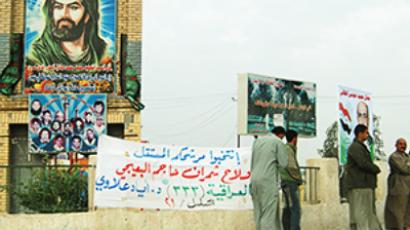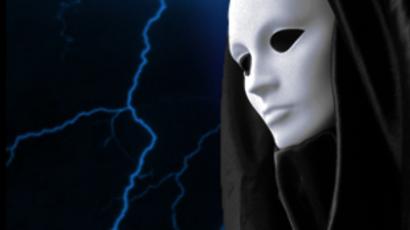The living dead
Shahid cemeteries are an Iranian vision of power, much more than any nuclear weapon. Many people visit the cemeteries to ask God to let them die as martyrs.
They pray and eat at them. They feel the presence of God and special brotherhood with their friend-in-arms.It’s Friday morning and the cemetery is crowded like Times Square on a Sunday.“Are you here because you are interested in our culture?” – that is the first question I hear as I enter a graveyard near Tehran. I hear it from a girl who is handing out commemorative treats on behalf of her family.There are all sorts of people here. Government loyalists and oppositionists, women in black chadors and light scarves that barely cover their abundant hair, scientists, students, bohemians and laborers. Families and loners, children and old men. People bring food in pans, thermos flasks and kettles. They hand out sweet tea and coffee, bean and spinach broth, candy, cookies, apples, even cucumbers. You can’t refuse the food. It is a ritual to express respect to the martyrs and heroes who died at war, killed by Saddam’s mustard gas, US chemical weapons or terrorist bombs planted in mosques and the parliament.A lone woman is sitting on a grave, her rich dyed hair barely covered by a headscarf. She is weeping loudly, like she buried a loved one today. But the grave she is sitting on is almost 30 years old. Her clothes are not what an outwardly religious woman would wear. She is crying for a martyr. This ritual is a special part of the religion.Mohammad Hussein is 30 years old. He is completing his graduate courses in management.“I try to come here every month. None of my relatives or loved ones are buried at this cemetery. I was a year old when the war (between Iraq and Iran) began. My parents love the Shahids but I can’t say this love is passed from generation to generation. Everyone makes the choice for themselves.” His wife and little children are with him. “Yes, they have made the choice as well. Everyone makes this choice, regardless of their age.”
“We consider every Shahid a perfect person who comes to know God before everyone else is judged. We believe the Shahids are the source of our power. That’s why there are so many people here. Shahids strengthen the spirit of the people. If someone wants to test it, they will come up against a spirit that will be even fiercer than what we showed in the last war,” Mohammad explains. He says that a Shahid is anyone who dies defending their country and faith, not suicide bombers who kill innocent people.The difference between Shahid martyrs and suicide bomber sects is not understood in the West. In Iran, people take in the difference with their mother’s milk.“If the Americans could, they would have attacked us earlier. They have missed their chance. They have tried to attack Iran and I doubt they will dare try again. They tested chemical weapons on our people in the 1980s. It looked like snow. Everyone who was caught in that bombardment died from burns. The Americans destroyed three of our cruisers. They shot down a passenger plane on its way to Dubai, killing 400 people,” Mohammad says in response to a question about why Iranians are not afraid of war or the US.
The scent of God
Said Shahloi Mogadam went through the war when he was 15. He is now the editor of the Basij Review, a quarterly political publication. His Basij discipline prevents him from letting me take his picture.“We believe in our Shahids. Our lives are intertwined in some way. We are nothing without them. They determine our path,” says Mogadam, speaking about the sacred and everyday aspects of talking to Shahids.“We go to visit Shahids’ families. During the Nowruz [Persian New Year] season, many of us visit old battlefields. Only people of our faith comprehend why we are so attached to our comrades. There, at the frontline, you can feel the scent of God. My friend was killed – and I feel that he is my brother now. It is a spiritual thing.”He eyes me with doubt – how can a foreigner understand such things? Mogadam tries to say the same thing in a simpler way.“You see, we miss our comrades. When we visit cemeteries and the places where we fought, we are happy. We follow Imam Hussein’s example and ask our fallen comrades to pray for us.”He is referring to the grandson of the Prophet Muhammad who lived in the 7th Century. When explaining their mindset, Iranians often refer you to those ancient times as something ordinary. This puzzles foreigners: the whole world is expecting that air strikes against Iran may start any time yet people in Iran remain placid.“Our people are ready to sacrifice their lives for Islam, and Americans understand this. The eight-year war with Iraq, a country that was assisted by all, confirmed that Iran can’t be broken down. At that time the Shah’s mercenaries and even foreigners fought against Iran. If our enemies press upon us, we won’t put up with that and won’t give up. This is the essence of what Imam Hussein has taught us,” Mogadam says.Mr. Suleimani, Mogadam’s brother-in-arms joins the conversation. Again, he doesn’t want to be photographed. He even refuses to reveal his full name.“War veterans stay in touch with each other. Do you know that there are many Shahids and veterans among our Jews and Armenians? There are many Shahids among the Sunnis, even more than among the Shiites. All of them are our brothers, fallen or alive. The volunteer is our people’s mindset. Of course, much of it comes from religion, but look at our Christian brothers, Jews and Sunnis. They have picked up the same mentality. It depends on the person. You may or may not have this in you. A real volunteer is the one who is mobilized because of his character,” Suleimani explains.
The faithful
The grave of 13 year-old Fahmid is a gathering place for his, at one time, peers. His tombstone is covered in flowers. Fahmid’s mother lived at the cemetery in a tiny house until she grew old and had to be taken to hospital. The boy signed up as a volunteer at the beginning of the last war. He strapped himself with a grenade belt and jumped under a tank when his unit ran out of shells.
People walk from one grave to another and read prayers, laying their hands on the tombstones. Some people invite readers and lay down a carpet.Fatima Ardistani pays a visit to the grave of her husband and son. Her husband was a bus driver before the war. He signed up to serve in the Army of the Guardians of the Islamic Revolution. When he died in 1980, her eldest son joined the army as a volunteer.“His father was brought to me without his legs and arms… my son patrolled the city every night for two years. He did his military training in the summer and volunteered to serve in the province of Kurdistan, on the border with Iraq. His brigade was called “Mohammad Rasul Allah.” A shell hit their trench. My son’s face was burned off, his body peppered with shards when they brought him to me. He was 15 and he died two years after his father,” Fatima’s voice rings dry while the men standing around us cover up their eyes to hide tears.Fatima’s friend Zeinab came to the cemetery with her.“Zeinab and her husband are from Esfahan. He husband was the head of the local revolutionary committee. They came to Tehran at the start of the revolution. They had nowhere to stay. My husband met them on the street and brought them to our house. We have been friends since then. Zeinab and her husband travel from Esfahan just to visit the cemetery with me. Her husband is here too. He fought in the war for three years. Now he goes around his comrades’ graves, looking for his friends.”
Fatima says she has a son and daughter. She got married after the war but it didn’t work out and she got divorced.“I get a pension the size of my husband’s salary. He gets raises as if he was still alive. Yes, it is enough. It’s even more than I need,” she says. Some of the Shahids’ families give their money to the poor if they themselves are provided for. The graves of those killed in Halabja are in a separate group. Here lie the citizens of Iraq killed in poisonous gas attacks launched by Saddam Hussein. Hussein was sentenced to death for these killings. The grave of the Iranian poet Mohammad Reza Aghasi is nearby and people flock to his place of rest.The grave of Shahid Sheikh Seyed Ahmad Polarak attracts crowds too: there are two separate queues to it – one for men and one for women. The grave is always moist. It emanates a scent. It is a phenomenon known in the Christian faith – some holy graves and icons have been known to emit an oily sweet-smelling substance called “myrrh”. People come up to the grave, whisper a prayer and anoint their hands and face in the myrrh.“He was a volunteer. A radio operator. Those who want to perfect their soul come here to ask him to be our petitioner to God. This is the first time I’m visiting his grave but I’ve read a lot about him. This is the only one of our Shahids whose grave emits such an aroma,” Majid Asadirat says.“You have to understand that the Shahids live on even after their death. People have no power over them. But they give their people strength of spirit,” says Majid, a respectable family man. He smiles as a tear runs down his cheek.
Nadezhda Kevorkova, RT














